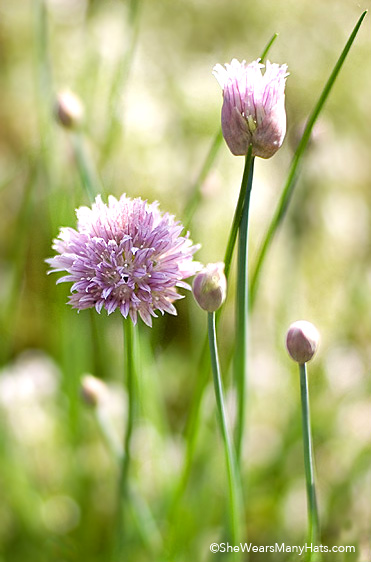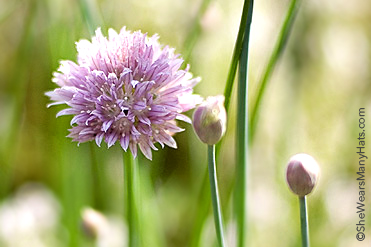Tips for Growing Chives
This post may contain Amazon or other affiliate links. As an Amazon Associate I earn from qualifying purchases.
A few handy tips and information for growing chives in your garden.
Chives make me smile. They’re so happy and perky—the little sprite of the garden! A thinner, milder version of green onions and scallions, chives not only add flavor to many dishes but a lovely texture and color to the garden.
As much as I enjoy chives I have noticed that other than an occasional topping for a salad or potatoes, I tend to overlook the chives, while the cilantro, basil, thyme and others get all the attention. That doesn’t seem quite fair, does it? Especially when chives are such a dependable and easy going plant.
Did you know that chives have natural insect repelling properties? Yes they do! Plant them next to roses to help prevent aphids.
As I mentioned, chives are dependable. They are a hardy perennial, with tolerance for most cold and drought. Chives can grow in most garden soil types, so it’s easy to grow a supply of chives in your garden or a container.
As far as culinary uses, chives tend to lose their flavor when cooked for long periods of time, that’s why they are best when used as a garnish, but not just for potatoes or soup. What about scrambled eggs or quiche? Potato or pasta salad? Or perhaps salsa? A vinaigrette? Chicken salad? Compound butter? Or maybe Sour Cream Cheddar and Chives Drop Biscuits? All of that sounds very nice to me.
I’m so thankful for the chives.
Dear chives, Thank you for being you. I promise not to overlook you anymore. I promise to appreciate how you adorn the herb garden. I may just plant some more of your friends to spread your joy all over the garden and landscape.
Information and tips for growing chives:
- Chives are a perennial and a member of the onion family.
- Chives grow best in USDA Hardiness Zones 3-10. If you live in the U.S., check this map to determine your zone: USDA Hardiness Zones
- Set chive plants out in early spring, spaced about 8-10 inches apart. If growing from seed, plant about 1/4-inch deep in early spring as soon as soil is 60-70-degrees F. Thin seedlings to about 4-6 inches apart.
- Chives like full sun the best but will also thrive in partial shade especially in warmer climates.
- While chives will tolerate most soils, they grow best in rich, well-drained soil. Prepare soil by adding compost and a all-purpose fertilizer in amounts recommended on packaging.
- Chives grow well in containers and are great to use as a perennial in your flower beds.
- To encourage growth of leaves, pinch off flower buds.
- To harvest snip leaves to about half an inch tall. Flower buds are also edible. Just pinch them off to add as a nice garnish to salads or soups.
- Chives will multiply if flowers are allowed to seed out. Mature plants can be divided and transplanted every few years.
What is your favorite way to use herbs? Is there an herb you are interested in growing? Or do you already have some that are doing well?
Originally posted April 27, 2010. Updated June 9, 2015.






Chive vinegar….. mmmmmm